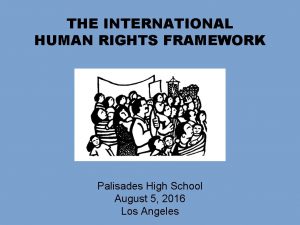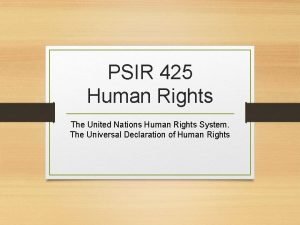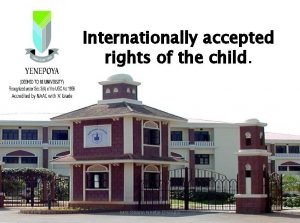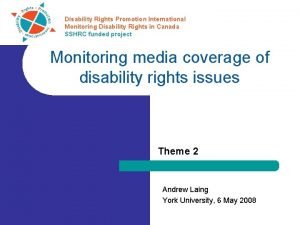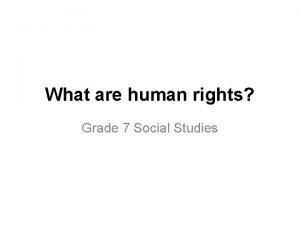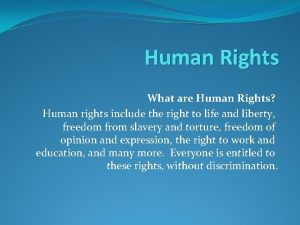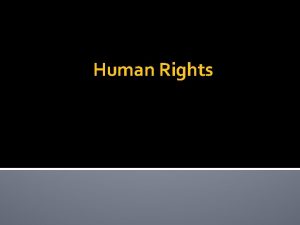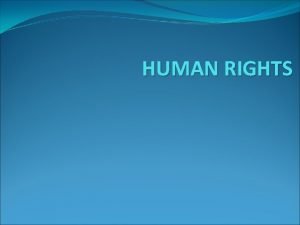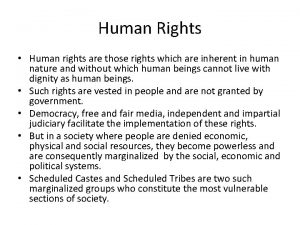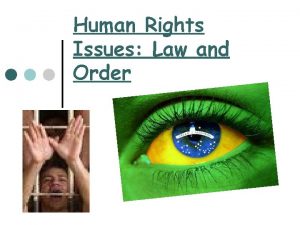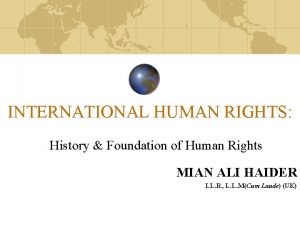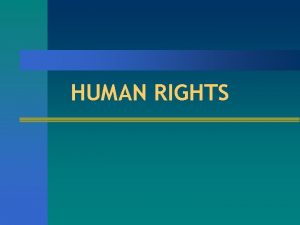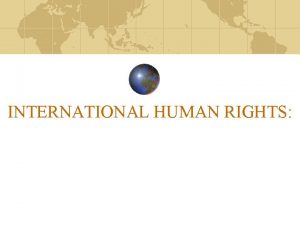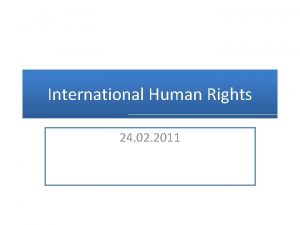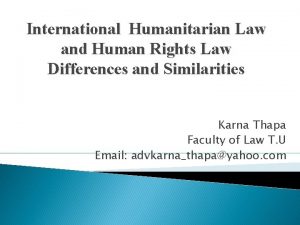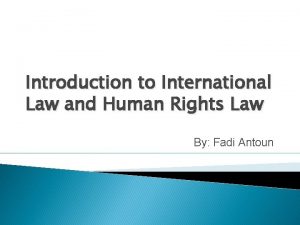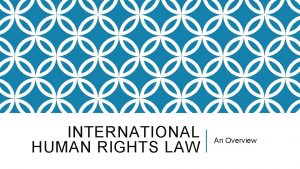International Human Rights Law International human rights law


















- Slides: 18

International Human Rights Law

International human rights law refers to the body of International Law designed to promote and protect human rights at the international, regional and domestic levels. As a form of international law, international human rights law is primarily made up of treaties (agreements) between states intended to have binding legal effect between the parties that have agreed to them; and customary international law (rules of law) derived from the consistent conduct of states acting out of the belief that the law required them to act that way. While other international human rights instruments contribute to the implementation, understanding and development of international human rights law and have been recognized as a source of political obligation.

Enforcement of International Human Rights Law can occur either on Domestic, Regional or International Level. States that ratify human rights treaties commit themselves to respecting those rights and ensuring that their domestic law is compatible with international legislation. When domestic law fails to provide a remedy for human rights abuses parties may be able to resort to regional or international mechanisms for enforcing human rights. So here we will study the following important international human rights instruments in which attempts have been made to enunciate or guarantee human rights standards:

1) UN Charter: It was not until the world witnessed and experienced the horrors of World War II that the need and realization for a universal Human Rights system for its protection became apparent and it resulted in the formation of the United Nations. The first UN conference was held in San Francisco between 25 th April to 26 th June 1945, at which the task to draft the UN Charter was accomplished. The UN Charter was the first international instrument to recognize that individuals have certain rights that are of Universal character and imposed an obligation on States to respect and promote such rights. Thus the UN Charter laid down the foundation of international Law of Human Rights.

• In all, there are seven references to human rights in this Charter, most important among which are; Article 1 that states the purposes and principles of the organization. • Article 13 (1) which notes that the General Assembly shall initiate studies and make recommendations regarding the realization of human rights for all. • Article 55 which provides that the United Nations shall promote “universal respect for, and observance of, human rights and fundamental freedoms for all without distinction, of race, sex, language or religion”. • And Article 56 which states that all members pledge themselves to take joint and separate action in cooperation with the organization for the achievement of the purposes set forth in Article 55.

So the Organization and its members in pursuit of the purposes stated in Article 1 shall act in accordance with the following principles: a) Sovereign equality. b) Member states are required to settle international disputes by peaceful means without endangering international peace and security. c) Member states shall refrain from threat or use of force against territorial integrity and political independence of any state.

2) International Bill of Rights: The Charter’s provisions on human rights are very general and vague. Therefore, the framers of the Charter left this task to the organization itself, and it was decided for this purpose that an International Bill of Rights should be drawn up. The International Bill of Human Rights comprises of: 1. Universal Declaration of Human Rights (1948), 2. International Covenant on Economic, Social and Cultural Rights (1966), 3. International Covenant on Civil and Political Rights and 4. Two Optional Protocols to the Covenant on Civil and Political Rights.

Universal Declaration of Human Rights (UDHR): The Universal Declaration of Human Rights is the basic international pronouncement of the inalienable and inviolable rights of all the members of the human family. Regarded as the first landmark in contemporary history in the development of the concept of human rights, the General Assembly adopted it on December 10, 1948 at its meeting in Paris. It, in fact, expresses the spirit of the Charter by setting out in detail what in the Charter was already included as one of the main aims and purposes of the UN. But, in the process of the definition of human rights, the Universal Declaration of Human Rights may be accepted as the true Magna Charta of mankind.

Cont’ However, as far as its contents are concerned it consists of a Preamble and 30 articles setting forth various human rights and fundamental freedoms. So its provisions can be classified into the following four categories: 1) General Articles (Art. 1 & 2) 2) Civil and Political Rights (Art. 3 - 21) 3) Economic, Social and Cultural Rights (Art. 22 – 27) 4) Concluding Articles (Art. 28 – 30)

Cont’ No doubt, UDHR was a remarkable achievement of the United Nations in the area of human rights, yet there were certain omissions in it, e. g. , • there is no provision in it regarding the protection of minorities, • it did not recognize any right of petition even at the national level • this Declaration is not a treaty it was adopted by the General Assembly as a “resolution” having no force of law. It was actually adopted to provide a “common understanding” of the human rights and fundamental freedoms and to serve “as a common standard of achievement for all peoples and nations”. But whatever may be the legal status and significance of the Declaration, ever since it adoption in 1948, it had been the most important and farreaching of all UN Declarations which had a marked influence upon the constitutions of many states and upon the formulation of subsequent human rights treaties and resolutions. Therefore, it can be said that the Universal Declaration of Human Rights is a milestone in the history of human rights.

Cont’ But while discussing the UDHR, an important fact to be known is that after the adoption of this declaration when attempts were being made to solidify its legal basis, different countries of the world sought to use the pars of the declaration that they felt supported their ideological vision of the world and ignore the rest. The United States sought to limit the concept of human rights to civil and political ones while the USSR and its allies counter-argued that economic and social rights were the very core of human rights. As a result, it took eighteen years, until 1966, for not one but two covenants to be adopted which include:

(a) International Covenant on Economic, Social and Cultural Rights (ICESCR): This Covenant was adopted by the General Assembly in 1966 and entered into force on 3 rd January 1977. But the State Parties ratifying the Covenant do not undertake to give “immediate effect” to the rights guaranteed under it. Instead, the State obligates itself merely to take steps “to the maximum of its available resources” in order to achieve progressively the full realization of these rights. But since economic, social and cultural rights cannot be fully realized without economic and technical assistance, it does not seem realistic to require immediate compliance of these rights.

Cont’ This Covenant comprises a Preamble and 31 articles divided into five parts. The list of economic, social and cultural rights included in this Covenant is longer and much more comprehensive than the UDHR. However, it provides for the submission of periodical reports to Economic and Social Council (ECOSOC) by state parties on measures taken for the implementation of the obligations under the Covenant and reasons for failure of such implementation. After considering the state parties report ECOSOC submits it to various specialized agencies of the United Nations and then to the General Assembly.

Cont’ It may be noted that the Covenant itself does not establish any special committee to review the reports. It merely stipulates that they are to be submitted to Economic and Social Council. In other words, the methods for the achievement of the rights recognized in this Covenant include conclusion of Convention, the adoption of recommendations and furnishing of technical assistance and the holding of seasonal meetings for consultation and study. Therefore, it is said that the rights and obligations under this Covenant are not much immediate.

(b) International Covenant on Civil and Political Rights (ICCPR):

Cont’ This Covenant also has a Preamble and 53 Articles which are divided into six parts. It covers all the rights of man, considered as a social being and as an individual. The list is extensive and the number of rights included is greater than given in the UDHR. However, it must be noted that all these rights are not absolute in nature but are subject to certain limitations whose formulations differ from article to article. Moreover, as part of the International Bill of Rights, it gives binding force to various traditional civil and political rights contained in the UDHR.

Cont’ Whereas the procedure of implementation provided under ICCPR is a “reporting procedure”. A Human Rights Committee (HRC) is established under part IV of the Covenant and all the State Parties to this Covenant are to submit their reports on the measures adopted by them in giving effects to the rights contained in this Covenant and on the progress made in the enjoyment of these rights to this committee. But Article 42 of the Covenant also provides for the establishment of an additional organ i. e. Adhoc Conciliation Commission so that if any matter referred to HRC is not resolved to the satisfaction of the parties concerned, the Committee may appoint an Adhoc Commission of five persons acceptable to the State Parties concerned. Moreover, this Covenant also provides for an inter-state complaint machinery that enables one State Party to charge another State Party with a violation of the treaty but this machinery is optional.

Sources: Suchinmayee, R. (2008). Gender, Human Rights and environment. New Delhi: Atlantic Publishers & Distributors. Sen, S. (2009). Human rights in a developing society. New Delhi: A. P. H. Publishing Corporation. Shaw, M. N. (1995). International law. Britain: Grotius Publications. Starks, J. G. (1989). International Law. London: Butterworth & Co (Publishers). Kohli, A. S. (2004). Human rights and Social Work: Issues, challenges and responses. New Delhi: Kanishka Publishers.
 Human rights bills
Human rights bills International bill of human rights
International bill of human rights Positive rights and negative rights
Positive rights and negative rights Riparian and littoral rights
Riparian and littoral rights Legal rights and moral rights
Legal rights and moral rights Legal rights and moral rights
Legal rights and moral rights Negative right
Negative right Positive vs negative rights
Positive vs negative rights Positive rights vs negative rights
Positive rights vs negative rights Negative right
Negative right Newton's first law and second law and third law
Newton's first law and second law and third law Newton's first law of motion
Newton's first law of motion Boyles law
Boyles law Charles law constant
Charles law constant List internationally accepted rights of the children
List internationally accepted rights of the children Disability rights promotion international
Disability rights promotion international International disability rights monitor
International disability rights monitor Human rights grade 7
Human rights grade 7 What evidence do you see of tojo being nationalistic?
What evidence do you see of tojo being nationalistic?
